
| Walsh considered cyclopropane as a combination of three methylene (CH2) units: | ||||||
| 3 | + | 3 | = |  |
||
However, it should be obvious that the σ-type and π-type methylene orbitals cannot combine, since they have different symmetries. We are left to make two separate sets of molecular orbitals for cyclopropane.
Combinations of the methylene a1 orbitals |
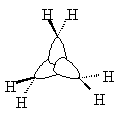 Group theoretical considerations tell us that those cyclopropane MOs derived by combining the σ-type methylene MOs must belong to either the A1´ or E´ irreducible representations of the D3h point group.
Group theoretical considerations tell us that those cyclopropane MOs derived by combining the σ-type methylene MOs must belong to either the A1´ or E´ irreducible representations of the D3h point group.
The orbital of A1´ symmetry (which we will call ψA1´) is qualitatively obvious; it is a totally symmetric combination of the three σ-type methylene orbitals. The a1´ orbital has net bonding character.
Rigorous derivation of the a1´ MO.
The orbitals of E´ symmetry are not so obvious. Two of them are needed, and they will be energetically degenerate. In order to qualitatively generate two e´ orbitals, pick one of the three vertical planes of symmetry and construct combinations that are respectively symmetric (ψE´,a) and antisymmetric (ψE´,b) to that plane. Notice that these orbitals have net antibonding character.
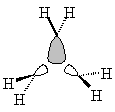 |
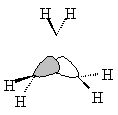 |
| symmetric | antisymmetric |
Rigorous derivation of the σ-type e´ MOs.
Combinations of the methylene b2 orbitals |
 The orbitals derived from the π-type methylene orbitals must belong to either the A2´ or E´ irreducible representations of the D3h group.
The orbitals derived from the π-type methylene orbitals must belong to either the A2´ or E´ irreducible representations of the D3h group.
Again, summing the three orbitals yields the more symmetric a2´ molecular orbital, ψA2´. This time, the A-symmetric orbital has net antibonding character.
Rigorous derivation of the a2´ MO.
Two orbitals of E´ symmetry are also required, and they will be energetically degenerate. In order to qualitatively generate two e´ orbitals, we again pick one of the three vertical planes of symmetry and construct combinations that are antisymmetric (ψE´,c) and symmetric (ψE´,d) to that plane. Notice that these orbitals have net bonding character.
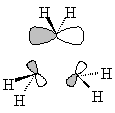 |
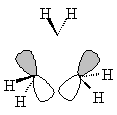 |
| antisymmetric | symmetric |
Rigorous derivation of the π-type e´ MOs.
| Background | Walsh Cyclopropane home | Orbital energy diagram |
Copyright © 1997 by Daniel J. Berger. This work may be copied without limit if its use is to be for non-profit educational purposes. Such copies may be by any method, present or future. The author requests only that this statement accompany all such copies. All rights to publication for profit are retained by the author.
Images generated with HyperChem Lite and ChemWindow Suite.